January 2010
Prior iPads
Given that there have been several web pad initiatives in the past, it should come as no surprise that there were iPads in the past. A brief scan through Pen Computing's archives revealed that LG Electronics announced the Digital iPad at CeBIT 2001, a multimedia-savvy Linux-based tablet handheld that offered Internet access, plus standard PIM features and word processing. A year later, the Fujitsu iPad that was announced by Fujitsu Transaction Solutions, Inc., at the 2002 National Retail Federation Expo in New York. The sleek 10 ounce device was based on Microsoft's CE .NET and Pen Computing commented on how the Fujitsu iPAD could function as a cordless phone (using WLAN and VoIP). A more detailed search would likely reveal others, but we're sure Apple was aware of them all and properly secured the name. -- Posted Friday, January 29, 2010
iPad: HotHardware.com weighs in
We highly respect our friends at HotHardware.com for their very detailed analyses and assessment of new hardware technology. They have now weighed in on the iPad. [See HotHardware.com's iPad's Identity Crisis and Apple's A4 CPU Showstopper] -- Posted Thursday, January 28, 2010
Neonode announces zBook reference design
Neonode, Inc., the Swedish Optical Touchscreen Technology Company, announced the launch of zBook, a new low cost touch screen reference design for e-book readers. zBook is the latest in a series of new innovative products based on the Company’s patented touchscreen technology, zForce. The zBook reference design is aimed at companies who develop and sell e-book readers that require 100% transparent touch windows, finger and stylus input and multi-touch functionality. -- Posted Thursday, January 28, 2010
Flood of iPad support announcements
A day after Apple announced the iPad, there's already a flood of announcements of all sorts of iPad peripherals, add-ons and other iPad goodies. Examples: Belkin's iPad cases, mobile learning firm inkling is heavily counting on the iPad, NearbyNow announced iPad extensions for its a mobile shopping and in-App advertising platform, educational institutions get in the game, with Abilene Christian University’s student-run media staff announcing its commitment to produce the first paper of its kind for Apple's iPad, and so on. ANd that's months before the device is actually available. -- Posted Thursday, January 28, 2010
InStat: iPad impressive, but Kindle not dead just yet
Market research firm InStat, while lauding the iPad's ebook potential, says Amazon's Kindle is not dead just yet. Recent InStat research found that Amazon is the leading brand of e-Book owned, that most e-book owners spend between $9 and $20 per month on e-books, and that worldwide e-reader shipments will increase from less than a million in 2008 to almost 30 million in 2013. -- Posted Thursday, January 28, 2010
Apple announces the iPad
After months of intense hype and speculation, Apple announced the iPad, a 7.5 x 9.6 inch tablet that's just half an inch thick and weighs just a pound and a half. The iPad has a 9.7-inch 768 x 1024 pixel multi-touch display, runs all iPhone apps and starts at US$499. There are also 3G versions that start at US$629. Apple announced a US$14.99/month limited and a US$29.99/month unlimited plan, without 2-year contract, and the iPad is unlocked. Apple also announced an iBook Store and special iPad versions of the iWorks apps. [Read full description of the new Apple iPad]
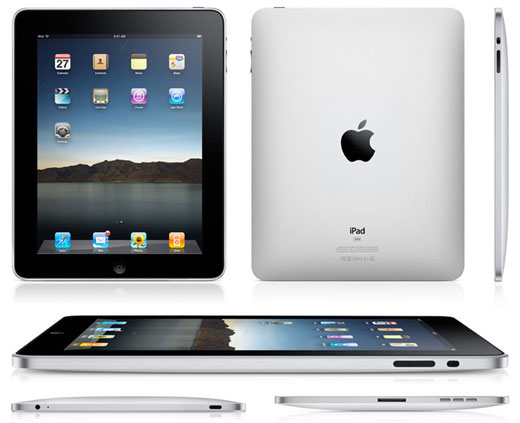 -- Posted Wednesday, January 27, 2010
-- Posted Wednesday, January 27, 2010
Treo gone, last of the old Palms
Palm is down to two models now, the Palm Pre Plus and the Palm Pixi Plus. No more Treos, and that means that the Palm OS as well as Windows Mobile-based Palms are now gone for good. -- Posted Tuesday, January 26, 2010
US$30 LCD writing tablets!
Kent Displays' revolutionary Reflex no power LCD technology is going to be available under the Improv Electronics name, with the Boogie Board LCD Writing Tablet its initial product. The Boogie Board it is the first paperless tablet to use a pressure-sensitive Reflex LCD for the writing surface made of impact-resistant, flexible plastic. The tablet requires no power to generate or retain an image, and only a small amount to erase. At a retail price of $29.97 USD, the Boogie Board tablet's cost per erase is 15 times less than the per sheet cost of paper in a comparable steno notepad. [See Boogie Board page andReflex LCD Writing Tablet backgrounder] -- Posted Monday, January 25, 2010
Kindle Development Kit
Amazon announced a limited beta Kindle Development Kit that will allow developers to come up with Amazon hopes innovative applications and perhaps unanticipated new uses for the Kindle that'll leverage the device's inherent eBook reader capabilities. Amazon's move is clearly a step towards keeping its options open in the eBook reader field that has huge potential but as of yet still no clear definition or truly compelling vision. -- Posted Monday, January 25, 2010
Eye-Fi Fo Fum
If it looks like our Dr. Tim has disappeared as of late, he hasn't. He's just been exploring some other areas in his vast fields of interest. The doctor is back now, though, and informs us of a deal that looks too good to be true, but isn't. Looks like Google has an irresistible offer where you get a free 4GB Eye-Fi wireless SD card if you sign up for their Picasa 200GB storage plan. Read more... -- Posted Wednesday, January 20, 2010
MobileDemand announces availability of ultra-compact xTablet 7000
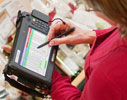 Leading Tablet PC provider MobileDemand announced the availability of the "Retail Ready" xTablet T7000, a rugged mini Tablet PC that combines the functionality of a notebook, full Windows OS and the portability and data collection capabilities of a handheld in a light-weight slate form factor with a built-in numeric keypad, optional QWERTY keyboard attachment, color camera and 7-inch high resolution (1024 x 600 & 768) all-light-readable touch screen display. [See full review of the Mobile Demand xTablet T7000] -- Posted Friday, January 15, 2010
Leading Tablet PC provider MobileDemand announced the availability of the "Retail Ready" xTablet T7000, a rugged mini Tablet PC that combines the functionality of a notebook, full Windows OS and the portability and data collection capabilities of a handheld in a light-weight slate form factor with a built-in numeric keypad, optional QWERTY keyboard attachment, color camera and 7-inch high resolution (1024 x 600 & 768) all-light-readable touch screen display. [See full review of the Mobile Demand xTablet T7000] -- Posted Friday, January 15, 2010
Nvidia Tegra 250 processor
Anticipating that everyone will want great graphics and full-speed HD video instead of the jerky stuff we get now in low-end platforms, NVIDIA keeps pushing ahead with its Tegra integrated processor initiative. At CES, they unveiled the Tegra 250 that offer lightning-quick browsing, streaming 1080p video and Adobe Flash Player 10.1 acceleration with an immersive 3D user interface and days of battery life. [See NVIDIA Tegra press release and NVIDIA Tegra Developer Zone] -- Posted Tuesday, January 12, 2010
Palm webOS developer program open
The Palm webOS developer program is open to any developer to sign up and start developing and distributing applications for webOS devices. Palm showcased its developer program and tools at 2010 CES, and announced a $1 million developer Hot Apps bonus program for the rapidly growing Palm webOS developer community. -- Posted Tuesday, January 12, 2010
TI also launches an eBook development platform
With the eBook market suddenly hot, Texas Instrument launched an OMAP 3 processor-based eBook development platform to help manufacturers and developers rapidly deploy their endless ideas to launch new, innovative eBook readers into consumers' hands. Touting a sleek electrophoretic display, TI's platform includes the new OMAP3621 applications processor, WiLink 6.0 WiFi/Bluetooth/FM "combo" connectivity solution, the new TPS6518x electronic paper display (EPD), power management IC, along with other TI analog solutions, and 3G modem connectivity support. [See TI's eBook development platform] -- Posted Tuesday, January 12, 2010
MSI U135 netbook now with SUSE Moblin
Like the new Atom N450-powered netbooks, but Windows 7 not so much? Soon you can get a MSI U135 netbook preloaded with SUSE Moblin version 2.1. [See the MSI U135 netbook] -- Posted Tuesday, January 12, 2010
Fingerprint-resistant screen protectors
There's nothing worse than a touchscreen full of smudges and fingerprints. Targus claims to have solved this problem with its new fingerprint-resistant line of screen protectors with Clear View technology that feature a microscopic landscape of ridges and valleys that work to dissipate fingerprint oils, thus leaving the screen virtually fingerprint and smudge free and also reduce glare. Available for a variety of smartphones and such for US$9.99. -- Posted Tuesday, January 12, 2010
Meet Alex
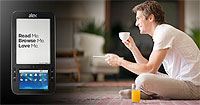 Alex is the tablet in the picture, not the guy. It's a dual-screen Marvell PXA303-powered Google Android-based eReader that seeks to integrate web browsing and reading. A 6-inch 600 x 800 pixel grayscale display is for ePUB-format eBook reading, a 320 x 480 3.5-inch touchscreen LCD for navigation and web browsing. There's 32GB of flash, a microSD slot, 802.11b/g WiFi, and the device is "compatible with 3G, EVDO/CDMA and GSM." Available for US$399 the end of February. [See Alex website] -- Posted Tuesday, January 12, 2010
Alex is the tablet in the picture, not the guy. It's a dual-screen Marvell PXA303-powered Google Android-based eReader that seeks to integrate web browsing and reading. A 6-inch 600 x 800 pixel grayscale display is for ePUB-format eBook reading, a 320 x 480 3.5-inch touchscreen LCD for navigation and web browsing. There's 32GB of flash, a microSD slot, 802.11b/g WiFi, and the device is "compatible with 3G, EVDO/CDMA and GSM." Available for US$399 the end of February. [See Alex website] -- Posted Tuesday, January 12, 2010
Slates and tablets: Deja Vue All Over Again
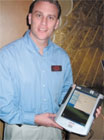 At the 2010 CES, Microsoft CEO Steve Ballmer played with a supposed HP slate during his keynote, disappointing those who'd bought into the massive tablet hype and had expected more in terms of real product. But wait, is the tablet shown in the picture to the right perhaps the new HP tablet? Nope. That was a Compaq tablet concept shown at the Tablet PC press event at the 2001 Comdex. Interestingly, back in 2001, there was actually a solid technological effort behind the (much more modest) hype, the Tablet PC project. See what all happened in 2001 and what was expected of tablets in a pilot version of Tablet PC Magazine (we pitched it to Microsoft; they were not interested). -- Posted Saturday, January 9, 2010
At the 2010 CES, Microsoft CEO Steve Ballmer played with a supposed HP slate during his keynote, disappointing those who'd bought into the massive tablet hype and had expected more in terms of real product. But wait, is the tablet shown in the picture to the right perhaps the new HP tablet? Nope. That was a Compaq tablet concept shown at the Tablet PC press event at the 2001 Comdex. Interestingly, back in 2001, there was actually a solid technological effort behind the (much more modest) hype, the Tablet PC project. See what all happened in 2001 and what was expected of tablets in a pilot version of Tablet PC Magazine (we pitched it to Microsoft; they were not interested). -- Posted Saturday, January 9, 2010
CNN reports on tablets at CES
Though there really wasn't much to see in terms of tablets at CESS, the current slate and tablet hype has even the biggies reporting and covering. CNN's contribution is a report entitled "What is a tablet anyway?" Well, it was really Microsoft that named the platform "Tablet PC" back in 2001. Before that, people usually spoke of pen computers or slates, though there were efforts to introduce other terms as well (like "pads"). CNN also reports that in the past, "Consumers couldn't touch the screens with their fingers to control the tablets," which, of course, is not true, but such is the reporting of history. -- Posted Saturday, January 9, 2010
Slate and tablet computers: learning from the past
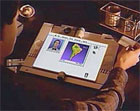 According to CNN, tablet-sized computers are now "a much-hyped category of electronics." But tablets were not invented by Microsoft in 2001, as many editors and industry pundits seem to think. Fact is, slate and tablet computers have been around for a good 20 years, and in 1991, there was as much hype about slates as we have today (see excerpts of "The Past and Future of Pen Computing" by RuggedPCReview.com editor Conrad H. Blickenstorfer). The image shows an Apple concept called the Knowledge Navigator from 1987, way before the World Wide Web was even invented. Read about Slate and tablet computers: learning from the past. -- Posted Thursday, January 7, 2010
According to CNN, tablet-sized computers are now "a much-hyped category of electronics." But tablets were not invented by Microsoft in 2001, as many editors and industry pundits seem to think. Fact is, slate and tablet computers have been around for a good 20 years, and in 1991, there was as much hype about slates as we have today (see excerpts of "The Past and Future of Pen Computing" by RuggedPCReview.com editor Conrad H. Blickenstorfer). The image shows an Apple concept called the Knowledge Navigator from 1987, way before the World Wide Web was even invented. Read about Slate and tablet computers: learning from the past. -- Posted Thursday, January 7, 2010
Google opens online store for Nexus One phone
Google unveiled a new way for consumers to buy an Android mobile phone, a web store hosted by Google. The company also launched the first phone offered through this new model, called the Nexus One, which combines the latest HTC hardware with the latest Google rev. 2.1 Android software. We're talking 3.7-inch AMOLED 480 x 800 touch (not multi!) display, Qualcomm Snapdragon chip, 5mp camera, SDHC card (up to 32GB), and a removable battery. The device costs US$179 with a 2-year T-Mobile contract, or US$529 without service. [See Google store with Nexus One] -- Posted Wednesday, January 6, 2010
Waterproof case for the Kindle
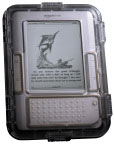 Those who are afraid to take their Kindle along because it might get wet or damaged, fear no more -- M-Edge has introduced the Guardian Case for Kindle. It's a polycarbonate affair that comes in six colors, allows full operation of the Kindle inside the case, and is even waterproof to a depth of about three feet. [See Kindle Guardian case product page] -- Posted Wednesday, January 6, 2010
Those who are afraid to take their Kindle along because it might get wet or damaged, fear no more -- M-Edge has introduced the Guardian Case for Kindle. It's a polycarbonate affair that comes in six colors, allows full operation of the Kindle inside the case, and is even waterproof to a depth of about three feet. [See Kindle Guardian case product page] -- Posted Wednesday, January 6, 2010
Broadcom navigation processor to support Android, Windows CE
Broadcom Corporation announced that it has ported the Android and Windows CE operating systems to run on its Broadcom BCM4760 navigation processor, enabling a new generation of location-aware mobile internet devices (MIDs) and personal navigation devices (PNDs). MIDs and PNDs are including increasingly sophisticated navigation functionality and location based services, and support for these OS platforms will make the devices attractive to a broader range of application developers, driving innovation and improved user experiences. -- Posted Wednesday, January 6, 2010
Lenovo hybrid Win7/Linux convertible tablet
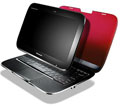 Lenovo introduced a rather odd device in the IdeaPad U1 hybrid tablet. Hybrid here stands not so much for using it as a tablet or a notebook (though you can), but for the U1 being both a Core 2 Duo-powered Windows 7 machine (when docked) and a Snapdragon-powered Linux slate (when using just the tablet/display). It's essentially two computers with that share some hardware (like the 11.6-inch multi-touch display, the battery, comms) but not memory or storage. The whole thing weighs 3.8 pounds, the tablet alone just 1.6, and pricing starts at US$999. -- Posted Wednesday, January 6, 2010
Lenovo introduced a rather odd device in the IdeaPad U1 hybrid tablet. Hybrid here stands not so much for using it as a tablet or a notebook (though you can), but for the U1 being both a Core 2 Duo-powered Windows 7 machine (when docked) and a Snapdragon-powered Linux slate (when using just the tablet/display). It's essentially two computers with that share some hardware (like the 11.6-inch multi-touch display, the battery, comms) but not memory or storage. The whole thing weighs 3.8 pounds, the tablet alone just 1.6, and pricing starts at US$999. -- Posted Wednesday, January 6, 2010
HP TouchSmart tm2: improved multi-touch
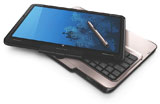 HP has updated their TouchSmart tx2 with the TouchSmart tm2, an elegant, aluminum-clad convertible Tablet PC with multi-touch capabilities on its 12.1-inch display. Sporting Intel Core 2 Duo processors, the tm2 gets up to nine hours of battery life, a variety of touch-optimized software (including "BumpTop," a touch-enhanced 3-D interface for photos and documents), a fingerprint reader, but no optical drive. Pricing starts at US$949. -- Posted Wednesday, January 6, 2010
HP has updated their TouchSmart tx2 with the TouchSmart tm2, an elegant, aluminum-clad convertible Tablet PC with multi-touch capabilities on its 12.1-inch display. Sporting Intel Core 2 Duo processors, the tm2 gets up to nine hours of battery life, a variety of touch-optimized software (including "BumpTop," a touch-enhanced 3-D interface for photos and documents), a fingerprint reader, but no optical drive. Pricing starts at US$949. -- Posted Wednesday, January 6, 2010
Synaptics Previews Scrybe
Synaptics, a developer of human interface solutions for mobile computing, communications, and entertainment devices, announced beta availability for Scrybe gesture workflows, a next-generation advancement in TouchPad-based interfaces for PCs. Scrybe is optimized for multi-touch TouchPads, but also supports existing single-touch TouchPads. It all reminds us a bit of macros that were all the rage in the late 80s and gestures in early handwriting reco systems, only with new and much more powerful technology. Check out Scrybe here. -- Posted Monday, January 4, 2010
Touch Revolution unveils "drop-in" NIM1000 module
Touch Revolution unveiled its new "drop-in" NIM1000 module designed to help OEMs integrate dynamic touch screen interfaces in a broad range of appliances and devices. Touch Revolution CEO Mark Hamblin, who previously served as the design lead for the original iPhone touch screen at Apple, said, “Our goal is to make it easy for manufacturers to offer iPhone-like touch interfaces while taking advantage of the NIM1000 module’s network and application processing capabilities as well as its suitability for high volume manufacturing. -- Posted Monday, January 4, 2010
Freescale proposes second-gen "Smartbook" tablets
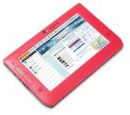 With netbooks selling by the millions and there being renewed interest in tablets, Freescale revealed a second-generation "Smartbook" reference design with a 1024 x 600 pixel 7-inch touch screen based on Freescale's i.MX515 processor incorporating ARM Cortex-A8 technology as well as other FreeScale chips and an accelerometer. The reference tablet measures 8 x 5 x 0.6 inches, weighs 13 ounces, has WiFi and Bluetooth (and a 3G modem option), 4-64GB of internal storage, a 3mp camera, and runs Linux or Android. Smartbooks baed on the platform should have prices under US$200, feature instant-on and just generally combine the best of smarthones and netbooks. [See FreeScale Smartbook reference design] -- Posted Monday, January 4, 2010
With netbooks selling by the millions and there being renewed interest in tablets, Freescale revealed a second-generation "Smartbook" reference design with a 1024 x 600 pixel 7-inch touch screen based on Freescale's i.MX515 processor incorporating ARM Cortex-A8 technology as well as other FreeScale chips and an accelerometer. The reference tablet measures 8 x 5 x 0.6 inches, weighs 13 ounces, has WiFi and Bluetooth (and a 3G modem option), 4-64GB of internal storage, a 3mp camera, and runs Linux or Android. Smartbooks baed on the platform should have prices under US$200, feature instant-on and just generally combine the best of smarthones and netbooks. [See FreeScale Smartbook reference design] -- Posted Monday, January 4, 2010
The global notebook leaders of 2010
According to Digitimes, here are the expected number of notebooks shipped globally during 2010: 1) HP 44 million, 2) Acer 40 million, 3) Dell 24.8 million, 4) Asustek 20 million, 5) Toshiba 18.8 million, 6) Lenovo 18 million. Of all those, about 34 millions are expected to be netbooks. -- Posted Monday, January 4, 2010
 -- Posted Wednesday, January 27, 2010
-- Posted Wednesday, January 27, 2010 Leading Tablet PC provider
Leading Tablet PC provider  Alex is the tablet in the picture, not the guy. It's a dual-screen Marvell PXA303-powered Google Android-based eReader that seeks to integrate web browsing and reading. A 6-inch 600 x 800 pixel grayscale display is for ePUB-format eBook reading, a 320 x 480 3.5-inch touchscreen LCD for navigation and web browsing. There's 32GB of flash, a microSD slot, 802.11b/g WiFi, and the device is "compatible with 3G, EVDO/CDMA and GSM." Available for US$399 the end of February. [See
Alex is the tablet in the picture, not the guy. It's a dual-screen Marvell PXA303-powered Google Android-based eReader that seeks to integrate web browsing and reading. A 6-inch 600 x 800 pixel grayscale display is for ePUB-format eBook reading, a 320 x 480 3.5-inch touchscreen LCD for navigation and web browsing. There's 32GB of flash, a microSD slot, 802.11b/g WiFi, and the device is "compatible with 3G, EVDO/CDMA and GSM." Available for US$399 the end of February. [See  At the 2010 CES, Microsoft CEO Steve Ballmer played with a supposed HP slate during his keynote, disappointing those who'd bought into the massive tablet hype and had expected more in terms of real product. But wait, is the tablet shown in the picture to the right perhaps the new HP tablet? Nope. That was a Compaq tablet concept shown at the Tablet PC press event at the 2001 Comdex. Interestingly, back in 2001, there was actually a solid technological effort behind the (much more modest) hype, the Tablet PC project. See what all happened in 2001 and what was expected of tablets in a
At the 2010 CES, Microsoft CEO Steve Ballmer played with a supposed HP slate during his keynote, disappointing those who'd bought into the massive tablet hype and had expected more in terms of real product. But wait, is the tablet shown in the picture to the right perhaps the new HP tablet? Nope. That was a Compaq tablet concept shown at the Tablet PC press event at the 2001 Comdex. Interestingly, back in 2001, there was actually a solid technological effort behind the (much more modest) hype, the Tablet PC project. See what all happened in 2001 and what was expected of tablets in a  According to CNN, tablet-sized computers are now "a much-hyped category of electronics." But tablets were not invented by Microsoft in 2001, as many editors and industry pundits seem to think. Fact is, slate and tablet computers have been around for a good 20 years, and in 1991, there was as much hype about slates as we have today (see
According to CNN, tablet-sized computers are now "a much-hyped category of electronics." But tablets were not invented by Microsoft in 2001, as many editors and industry pundits seem to think. Fact is, slate and tablet computers have been around for a good 20 years, and in 1991, there was as much hype about slates as we have today (see  Those who are afraid to take their Kindle along because it might get wet or damaged, fear no more -- M-Edge has introduced the Guardian Case for Kindle. It's a polycarbonate affair that comes in six colors, allows full operation of the Kindle inside the case, and is even waterproof to a depth of about three feet. [
Those who are afraid to take their Kindle along because it might get wet or damaged, fear no more -- M-Edge has introduced the Guardian Case for Kindle. It's a polycarbonate affair that comes in six colors, allows full operation of the Kindle inside the case, and is even waterproof to a depth of about three feet. [ Lenovo introduced a rather odd device in the IdeaPad U1 hybrid tablet. Hybrid here stands not so much for using it as a tablet or a notebook (though you can), but for the U1 being both a Core 2 Duo-powered Windows 7 machine (when docked) and a Snapdragon-powered Linux slate (when using just the tablet/display). It's essentially two computers with that share some hardware (like the 11.6-inch multi-touch display, the battery, comms) but not memory or storage. The whole thing weighs 3.8 pounds, the tablet alone just 1.6, and pricing starts at US$999. -- Posted Wednesday, January 6, 2010
Lenovo introduced a rather odd device in the IdeaPad U1 hybrid tablet. Hybrid here stands not so much for using it as a tablet or a notebook (though you can), but for the U1 being both a Core 2 Duo-powered Windows 7 machine (when docked) and a Snapdragon-powered Linux slate (when using just the tablet/display). It's essentially two computers with that share some hardware (like the 11.6-inch multi-touch display, the battery, comms) but not memory or storage. The whole thing weighs 3.8 pounds, the tablet alone just 1.6, and pricing starts at US$999. -- Posted Wednesday, January 6, 2010 HP has updated their TouchSmart tx2 with the TouchSmart tm2, an elegant, aluminum-clad convertible Tablet PC with multi-touch capabilities on its 12.1-inch display. Sporting Intel Core 2 Duo processors, the tm2 gets up to nine hours of battery life, a variety of touch-optimized software (including "BumpTop," a touch-enhanced 3-D interface for photos and documents), a fingerprint reader, but no optical drive. Pricing starts at US$949. -- Posted Wednesday, January 6, 2010
HP has updated their TouchSmart tx2 with the TouchSmart tm2, an elegant, aluminum-clad convertible Tablet PC with multi-touch capabilities on its 12.1-inch display. Sporting Intel Core 2 Duo processors, the tm2 gets up to nine hours of battery life, a variety of touch-optimized software (including "BumpTop," a touch-enhanced 3-D interface for photos and documents), a fingerprint reader, but no optical drive. Pricing starts at US$949. -- Posted Wednesday, January 6, 2010 With netbooks selling by the millions and there being renewed interest in tablets, Freescale revealed a second-generation "Smartbook" reference design with a 1024 x 600 pixel 7-inch touch screen based on Freescale's i.MX515 processor incorporating ARM Cortex-A8 technology as well as other FreeScale chips and an accelerometer. The reference tablet measures 8 x 5 x 0.6 inches, weighs 13 ounces, has WiFi and Bluetooth (and a 3G modem option), 4-64GB of internal storage, a 3mp camera, and runs Linux or Android. Smartbooks baed on the platform should have prices under US$200, feature instant-on and just generally combine the best of smarthones and netbooks. [See
With netbooks selling by the millions and there being renewed interest in tablets, Freescale revealed a second-generation "Smartbook" reference design with a 1024 x 600 pixel 7-inch touch screen based on Freescale's i.MX515 processor incorporating ARM Cortex-A8 technology as well as other FreeScale chips and an accelerometer. The reference tablet measures 8 x 5 x 0.6 inches, weighs 13 ounces, has WiFi and Bluetooth (and a 3G modem option), 4-64GB of internal storage, a 3mp camera, and runs Linux or Android. Smartbooks baed on the platform should have prices under US$200, feature instant-on and just generally combine the best of smarthones and netbooks. [See